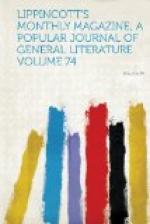Two things which have especially tended to give the Raskol a democratic—or even liberal—complexion are serfdom and the bureaucratic despotism of the country. It was no mere coincidence which caused the Raskol to break out about half a century after serfdom was established. Much of its popularity and life was due to the enslavement of the mass of the people. The slave was proud of having a different faith from his master; and slavery is always a propitious soil for the growth of sects. This nation of serfs dimly felt the Raskol to be an assertion of religious liberty and self-respect against master, Church and government; and these were symbolized by the beard and the peculiar sign of the cross. The Raskol offered to all the oppressed a moral, and often a material, refuge, an asylum for all enemies of the master and the law, and a shelter for the fugitive serf, for the deserter, for public debtors and outlaws of every description. Some sects (as the Wanderers, for example) are specially organized for such purposes. In these respects the Raskol was unconsciously one form of the opposition to serfdom and official despotism; and hence the Old Believers are most numerous among the most refractory elements of Russia—in the North among the free peasants (the old colonists of Novgorod), and in the South among the independent Cossacks of the steppes. Religious and political opposition have joined hands, and to this combination is due the strength of the great popular movements of the seventeenth and eighteenth centuries, such as the Streltsy insurrections at the time of the revolt of Pougatchef, whose excesses curiously recall the wars of the Peasants and Anabaptists in the West before the abolition of serfdom. In the great Russian Jacquerie, and in all the seditions which held out the hope of emancipation, the first place was taken by the Old Believers and the Cossacks, most of whom held the same faith. These two forms of national resistance are naturally akin. They equally personify the character and the prejudices of the old Russian. Their main point is their character of protests, so that an Old Believer may be described as a Cossack in religion, transporting into that domain the instincts peculiar to the wild horsemen of the Don. But both Cossack and Starovere have found themselves forced to give way before the march of civilization, and the different branches into which the Raskol has split have reached very divergent conclusions both as to politics and religion.




